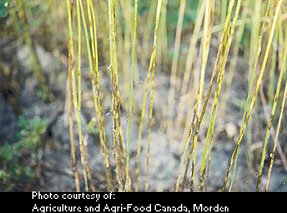Pasmo In Flax
Pasmo seldom causes serious damage. Occasionally, it can cause defoliation and premature ripening. Depending on the timing and severity of the infection, this disease can reduce the yield and quality of seed and fibre. Most losses are due to premature ripening and loss of seed during harvest.

Host Crops
Flax
Biology
Pasmo infections increase with prolonged wet periods in late summer and autumn. The pasmo pathogen is seed-borne. It also overwinters in the soil on infected flax stubble. Spores, dispersed by wind and rain, cause the initial infections on leaves and stems. It attacks above-ground parts of the plant.
The disease is more common in Manitoba with its moist climate than in the drier production areas of Alberta and Saskatchewan. Although flax is most susceptible to pasmo in the ripening stage, it can occur early in the season when warm, moist conditions prevail.
Lodging favours the development of pasmo, because of increased humidity within the crop canopy. This leads to patches of dead plants completely covered with the fungus.
Symptoms Of Damage
Pasmo is characterized by circular, brown lesions on the leaves and by brown to black infected bands that encircle the stem. These bands alternate with green, healthy bands, making pasmo easy to identify. Flowers and young bolls are also blighted. Older bolls are discoloured and contain shrivelled or non-viable seed.
Scouting Techniques
Look for banding of the stems and browning of the bolls.
Economic Thresholds
None available.
Control Tips
- Most commercial varieties lack resistance to this fungus. Pasmo can be controlled by using a crop rotation of at least 3 years to non-host crops and using clean seed.
- Early seeding, at the recommended rates, can reduce infection by avoiding high moisture conditions in the fall.

